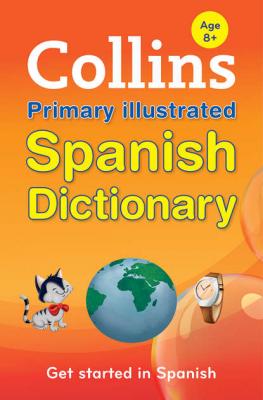Collins Primary Dictionaries. Collins Dictionaries
Чтение книги онлайн.
Читать онлайн книгу Collins Primary Dictionaries - Collins Dictionaries страница 3

Step four:
Parts of Speech
Sometimes, to pick the right translation, you need to know the part of speech of a word, for example whether a word is a noun, an adjective, an adverb or a verb.
NOUNS
Nouns are naming words for things or people. You often use the words ‘a’ or ‘the’ with a noun – eg a girl, a boy, the school, the windows.
Nouns can be singular, eg an accident, the playground, my dad, football – or plural, eg sweets, the children, my friends.
13 How many nouns are there in this sentence? What are they? The car has got a flat tyre and a big dent in the door.
ADJECTIVES
An adjective is a describing word which tells you what things are like: flat shoes are shoes that don’t have high heels. A flat tyre is a tyre with no air in it.
14 How many adjectives are there in this sentence? What are they? She’s got brown hair and blue eyes.
Some words have a noun meaning and an adjective meaning. In the dictionary there is a box to tell you about this. The different meanings usually have different translations in Spanish.
patient
patient can be a noun or an adjective.
A NOUN
el/la paciente masc/fem
B ADJECTIVE
paciente masc & fem The teacher is very patient. El maestro es muy paciente. Be patient, Joshua. Ten paciencia, Joshua.
ADVERBS
An adverb is a word which describes a verb or an adjective:
She writes neatly. The film was very good.
15 How many adverbs are in this sentence? What are they? The children sat quietly and played happily.
VERBS
Verbs are sometimes called ‘doing words’. They often go with words like ‘I’ and ‘you’, and with names, eg I play football, what do you want?, Hugo likes mashed potato.
Verbs tell you about the present,
eg I’m listening – the past, eg I scored a goal – and the future, eg I’m going to get an ice cream.
16 How many verbs are there in this sentence? What are they? School starts at 9.00 and finishes at 3.30.
Some words have a noun meaning and a verb meaning. In the dictionary there is a box to tell you about this. The different meanings have different translations in Spanish.
rain
rain can be a noun or a verb.
A NOUN
la lluvia fem in the rain bajo la lluvia
B VERB
to rain llover It’s going to rain. Va a llover. It rains a lot here. Llueve mucho aquí.
It’s raining. Está lloviendo.
17 What is the Spanish word for ‘rain’?
18 Why is ‘It’s going to rain.’ in part B?
19 How do you say ‘It’s raining.’ in Spanish?
20 Is ‘llover’ a noun or a verb?
Learn useful phrases
In the dictionary you’ll see phrases that are especially important in orange boxes. Try to learn these when you come across them, and you’ll soon know lots of useful things to say in Spanish.
What time is it? Qué hora es? It’s lunch time. Es la hora de comer. How many times? ¿Cuántas veces? Have a good time, Amanda! ¡Que lo pases bien, Amanda!
Find out about life in Spain
There are also boxes which tell you about Spanish customs, and about differences between life in Spain and Britain.
Did you know?
churros are a kind of fritter that people often eat on the streets in a paper bag or order in a café typically with a cup of thick, hot chocolate: chocolate con churros.
Even more words
At school you will learn to talk about subjects such as the time and the weather, your family, your pets, and your clothes. The most important words for talking about these subjects are shown in the dictionary itself, and even more words are given in Language Plus, the middle part of the dictionary. Have a look!
Answer key
1 ver and teléfono
2 It is the Spanish side. It has Spanish words on it and Spanish–English written at the side near the top.
3 Spanish-English
4 The last word
5 aburrirse
6 Arturo, Carmen, David, Isabel, Jorge, Juan, María
7 Jorge – because ‘o’ comes before ‘u’
8